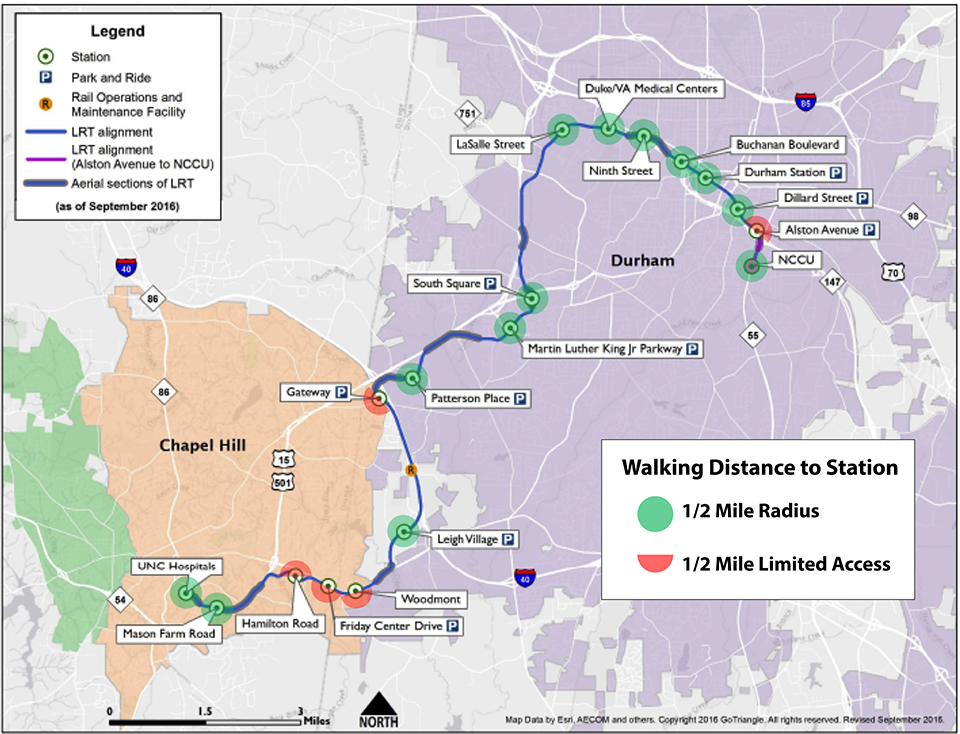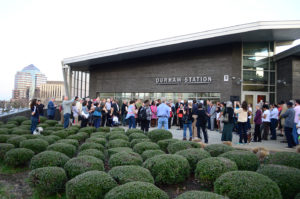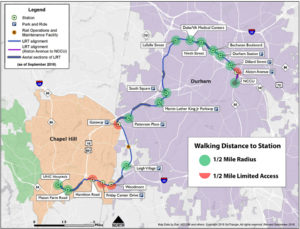Developable Areas Around LRT Stations: Fact Vs. Fiction ?
The short answer is hardly any now. There are only four stations planned for Orange County: UNC Hospitals, Mason Farm, Hamilton Road and UNC Friday Center. UNC is the primary land owner in three of them where the light rail route enters Orange County. UNC has not shared its plans for its properties and does not pay taxes.
Transit Oriented Development (TOD) is elegantly explored in this article by Tony Blake, Don’t Count your TOD Chickens.
Only one station is located on non-UNC property but there is little possibility or potential for Town or County growth at the Hamilton Road stop. East West Partners recently redeveloped this station area with a large mixed mixed use development including retail, hotel and apartments. The complex has received mixed reviews and retail has struggled. On the south side of the 54 East development lies the UNC owned Finley Golf Course. Eliminating the golf course could result in partial redevelopment in the areas that are not in the flood plain. Glenwood Elementary School is a small site owned by the school system but there are no current plans to sell the property.
It should be noted that two of the station stops Hamilton Road and Woodmont,(which is in Durham County) were proposed as possible candidates for elimination in the Go Triangle agreement if cost cutting measures were needed.

What happened at the GoTriangle Station Workshops in 2018?
Early in 2018, Gotriangle hired a consultant to plan land use around the station areas in Durham and Orange Counties. They held several planning sessions in April for Orange County and held another one with Chapel Hill advisory board members last week. At the outset there were three major problems with this Gotriangle effort:
- First, the primary property owner, UNC, was not part of any of the sessions so the resulting ideas and concepts don’t serve the needs of the principle client and beneficiary, making any ideas discussed unreliable. If light rail is approved, UNC is expected to bring their Carolina North campus to the 54 Corridor – further limiting the possibility of growth for the Chapel Hill and Orange County commercial tax base.
- Second, none of the places Orange County earmarked for economic growth and where major investments have been made by taxpayers are near the planned light rail stations.
- Third, the stations are not located at places in Chapel Hill where the Comprehensive plan stipulates that growth will occur.
The enthusiasm for Orange County economic development along the rail line does not match the facts on the ground. Check out this zoom in map of the light rail in Orange County. When the route enters Orange County it travels through Corps of Engineers wetlands adjacent to a major water supply water supply Jordan Lake. Then the route travels through neighborhoods such as Downing Creek in Durham and then Meadowmont, Laurel Hill, and Morgan Hills in Chapel Hill, Orange County. It is unlikely that residents of these areas thought that voting for a transit tax would mean that a new rail line would serve as an impetus for “redeveloping” their neighborhood, yet at the recent workshop the redevelopment of Meadowmont was seriously discussed.
A GoTriangle consultant spent time on possible economic development in Orange County around the Gateway station located near I-40. While the Gateway station is in Durham County, a last minute change in the implementation agreement moved the station closer to the Orange County line and to the potential redevelopment of Easttowne by UNC Health, the new owner. This parcel is located on the west side of 15-501. A bridge would need to be built over 15-501 to make this area walkable in fact. It’s not clear what tax rewards would accrue from the economic development near Gateway for Orange County as UNC is the land owner.
Although Chapel Hill is planning growth along 15-501 by approving Wegmans and projects in the Ephesus-Fordham area, the 15-501 corridor will not be served by the Gateway station stop on this expensive transit line. Meanwhile Brian Litchfield and Chapel Hill Transit are left scrambling to search for grants to find ways to increase bus service for this area.
If the Federal Transportation Administration were not to approve federal funding, new Orange County transit tax monies could be reprogrammed for Bus Rapid Transit along this important corridor, as well as funding the BRT on Martin Luther King Blvd, another area of intense development. Local elected officials who supported the light rail project must be held accountable for the wasted millions of local dollars spent on engineering — those funds will not be reimbursed – if this were to happen.











Follow Us